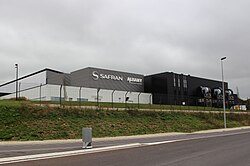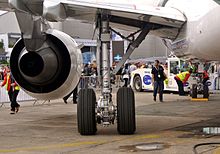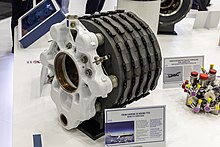
An auxiliary power unit (APU), is a device on a vehicle that provides energy for functions other than propulsion. They are commonly found on large aircraft and naval ships as well as some large land vehicles. Aircraft APUs generally produce 115 V AC voltage at 400 Hz (rather than 50/60 Hz in mains supply), to run the electrical systems of the aircraft; others can produce 28 V DC voltage. APUs can provide power through single or three-phase systems. A jet fuel starter (JFS) is a similar device to an APU but directly linked to the main engine and started by an onboard compressed air bottle.

An aerospace manufacturer is a company or individual involved in the various aspects of designing, building, testing, selling, and maintaining aircraft, aircraft parts, missiles, rockets, or spacecraft. Aerospace is a high technology industry.

The CFM International CFM56 series is a Franco-American family of high-bypass turbofan aircraft engines made by CFM International (CFMI), with a thrust range of 18,500 to 34,000 lbf. CFMI is a 50–50 joint-owned company of Safran Aircraft Engines of France, and GE Aerospace (GE) of the United States. GE produces the high-pressure compressor, combustor, and high-pressure turbine, Safran manufactures the fan, gearbox, exhaust and the low-pressure turbine, and some components are made by Avio of Italy and Honeywell from the US. Both companies have their own final assembly line, GE in Evendale, Ohio, and Safran in Villaroche, France. The engine initially had extremely slow sales but has gone on to become the most used turbofan aircraft engine in the world.

Safran Helicopter Engines, previously known as Turbomeca, is a French manufacturer of low- and medium-power gas turbine turboshaft engines for helicopters. The company also produces gas turbine engines for aircraft and missiles, as well as turbines for land, industrial and marine applications.

CFM International is a Franco-American aircraft engine manufacturer. The company is a joint venture between GE Aerospace and Safran Aircraft Engines and is headquartered in Cincinnati, Ohio. It was founded in 1974 to build and support the CFM56 series of turbofan engines. CFM is the world's largest commercial aircraft engine manufacturer, with a 39% market share as of 2020. It has delivered more than 37,500 of its engines to more than 570 operators. The name CFM is derived from the two parent companies' commercial engine designations: GE's CF series and Snecma's M series.

Safran Aircraft Engines, previously Snecma or Snecma Moteurs, is a French aerospace engine manufacturer headquartered in Courcouronnes and a subsidiary of Safran. It designs, manufactures and maintains engines for commercial and military aircraft as well as rocket engines for launch vehicles and satellites.
SIA Engineering Company Limited is a Singaporean company specializing in aircraft maintenance, repair, and overhaul (MRO) services in the Asia-Pacific. It is a wholly-owned subsidiary of the Singapore Airlines Group (SIA), formed in 1992 by separating SIA's engineering division.

Safran Landing Systems, formerly Messier-Bugatti-Dowty, is the world's largest manufacturer of aircraft landing gear, and is involved in the design, development, manufacture and customer support of all types of aircraft landing gear, wheels and brakes. The company is a wholly owned subsidiary of Safran SA. It is based in Vélizy, France, and was founded in 2011.
SAGEM was a French company involved in defense electronics, consumer electronics, and communication systems.
Zodiac Aerospace was a French aerospace group, active from 1896 to 2018, that supplied systems and equipment for aircraft. In October 2018, it was acquired by French aerospace and defense company Safran.

Avio S.p.A. is an Italian company operating in the aerospace sector with its head office in Colleferro near Rome, Italy. Founded in 1908, it is present in Italy and abroad with different commercial offices and 10 production sites. Avio operates in:

Hellenic Aerospace Industry (HAI) is the leading aerospace company of Greece. The company headquarters is located in Tanagra, 65 kilometers north-west of Athens, with the industrial complex covering an area of 200,000 sq.m.

Vulcain is a family of European first stage rocket engines for Ariane 5 and Ariane 6. Its development began in 1988 and the first flight was completed in 1996. The updated version of the engine, Vulcain 2, was first successfully flown in 2005. Both members of the family use liquid oxygen/liquid hydrogen cryogenic fuel. The new version for Ariane 6 is called Vulcain 2.1.
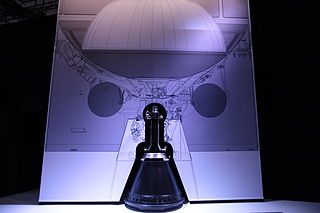
Vinci is a restartable, cryogenic, liquid-propellant rocket engine that powers the upper stage of Ariane 6. While development began in 1998 for the planned Ariane 5ME upgrade, funding for that programme shifted in 2014 to prioritize the development of Ariane 6, making Vinci the engine for the new launcher.
Airbus Defence and Space is a division of Airbus SE. Formed in 2014 in the restructuring of European Aeronautic Defence and Space (EADS), Airbus SE comprises the former Airbus Military, Astrium, and Cassidian divisions. Contributing 21% of Airbus revenues in 2016, it is the second largest space company in the world.

ArianeGroup is an aerospace company based in France. A joint venture between Airbus and Safran, the company was founded in 2015 and is headquartered in Issy-les-Moulineaux near Paris. It consists of three core groups: aerospace, defence, and security. ArianeGroup has developed its next-generation two-stage Ariane 6 launch vehicle, which succeeded the Ariane 5 rocket, that had more than 110 launches. The new vehicle offers two variants that will be capable of carrying between 10,350 and 21,650 kilograms. The first launch of Ariane 6 occurred on July 9 2024.
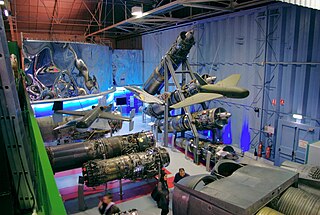
The Musée aéronautique et spatial Safran is a French private aviation museum located in Melun, Seine-et-Marne. Established in May 1989 the museum contains a large collection of historic and modern aircraft engines. These engines have been produced by various French engine manufacturers such as Gnome et Rhône and Snecma which are now part of the present day Safran company. The latter is the creator and manager of the museum.
Société d'étude et de réalisation d'engins balistiques or SÉREB was a French aerospace company.
OEMServicesSAS, or OEMS for short, is a French company involved in the maintenance, repair, overhaul, logistics and customer support of commercial aircraft. It is a joint venture between aerospace giants Safran, Thales, Diehl and Liebherr, acting as their AOG and MRO subsidiary for Aircraft Component Maintenance and spillover support.

